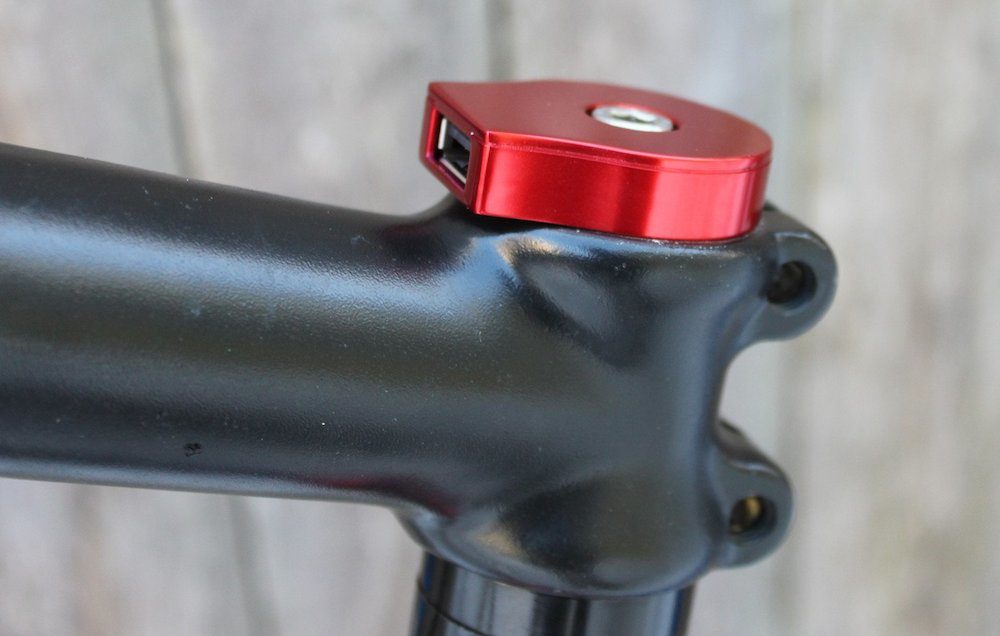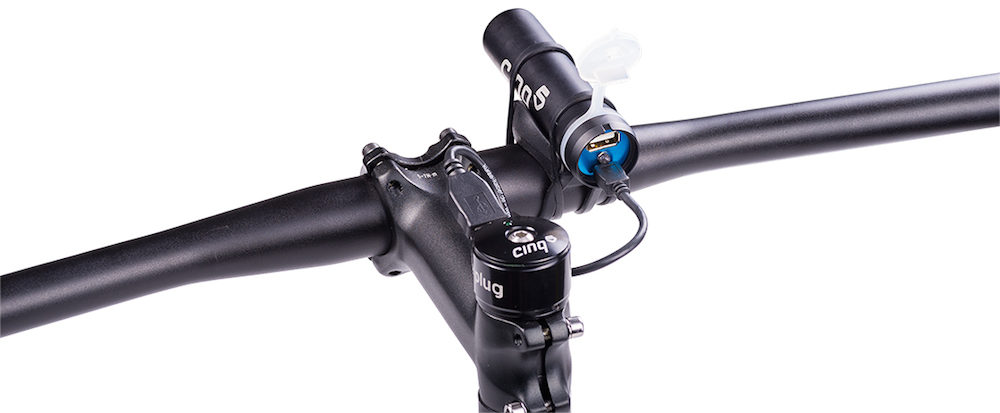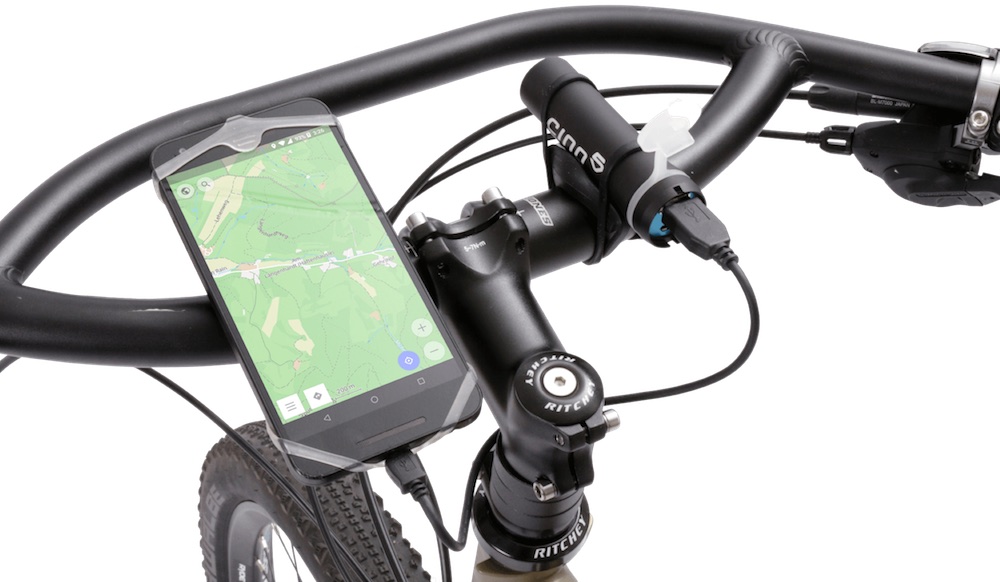Table of Contents
If you’re keen on charging electronics while you ride, you’re probably already aware of buffer batteries.
These special batteries provide continuous power to your devices during times when your speed is too low for USB charging, for example, when cycling on hilly terrain, or when stopped at traffic lights. This prevents your devices from receiving then losing charge (eg. smartphones) or switching themselves off entirely (Garmin eTrex models).
We’ll be taking a closer look at buffer batteries, battery storage, charging times and some dynamo chargers with in-built batteries in this article.

Pass-Through Batteries
Most batteries will either charge OR send their stored power to your device; rarely will they do both simultaneously.
Pass-through batteries are able to deliver power from your hub straight to your device, while also taking a charge if there’s any power leftover.
The reason many battery manufacturers don’t allow pass-through is that it can deteriorate batteries quickly, although you can still expect a minimum of 500 total charge/discharge cycles with most pass-through batteries (two half charges equate to one full cycle).
It’s worth noting that many manufacturers include “pass-through” as a feature on the battery spec sheet, but in my experience, this is rarely the case.
Battery Storage Losses
When power is stored in a battery, it experiences a storage loss of 15-20%. In order to minimise this loss, it is best to try to charge your electronics either straight from the USB charger or by using a pass-through battery. It’s nice to have that power on tap, but when it means you lose 1-hour of power per 5-hour ride… it adds up.
Lipstick Buffer Batteries
Batteries are getting smarter circuitry in order to reduce long-term deterioration. But not all batteries are smart!
Jesse Carlsson and Sarah Hammond use the cheapest lipstick batteries they can find to keep a constant stream of power running to their Garmin eTrex GPS units. It’s not guaranteed that the cheapest batteries will be ‘dumb’ enough to allow pass-through, but the odds are good and given they’re less than $10 – it’s worth giving them a go.
Check out Jesse and Sarah’s video on how to waterproof these cheap buffer batteries in their video HERE.
Variable Current Buffer Batteries

If lipstick batteries are dumb, variable current buffer batteries are smart!
A current limiting buffer battery is designed for dynamo hub charging, allowing you to switch between set charging currents (eg. 100, 400 or 900mA) for different riding speeds.
The main advantage is that you can optimise your charging current so that your battery can draw a charge at really low speeds (eg. 6-8km/h). This kind of feature is also handy for charging with solar panels in low-light conditions.
If you’re riding at higher speeds, however, these batteries are less useful because they limit your charging potential to 4.5-watts (many modern dynamo chargers will charge at between 5 and 7-watts once you hit 20kph).
You can see the power graphs for different dynamo USB chargers HERE.
Soshine E4S Battery Kit
This buffer battery kit has been recommended by Velogical, who make rim dynamo charging systems.
The E4S requires 2x 18650 Li-ion batteries (sold separately) to complete the kit. Velogical recommends Samsung INR 18650-29E batteries.
Make sure to pre-charge the buffer batteries using a regular USB charger with a type-B plug.
How Long Will A Battery Take To Charge?
To understand this section well, you may need to learn about volts, amps and watts HERE.
A 3-watt dynamo hub will put out an average of around 6-volts at 500mA. Once the power has been converted from AC to DC the output will translate to roughly 5V and 500mA (or 2.5 watts), which for an hour of riding is 500mAh. Charging a 3000mAh battery from scratch will, therefore, equate to 6 hours of riding at 12km/h with the most powerful USB chargers, and 20km/h with other USB chargers.
However, there are also small losses in the charging circuitry, perhaps around 20% of the total generated power. Adding the 20% extra ride time (6 hours + (6 hours x 0.2)) and we’re looking at 7.2 hours of riding to fill the battery from scratch.
You can also use the above assumptions when determining how long it will take to fill a phone battery. My Apple iPhone SE has a ~1500mAh battery, so at 500mA per hour, it should take 3 hours. Adding in the circuitry losses and I’m looking at 3.6 hours of riding to fill it up. Other modern smartphones like the Samsung S8 will have 3000mAh batteries, resulting in 7 hour + charge times.
Having said all that, there are products which use special capacitors to achieve twice the power, charging smartphones in literally half the time. Many of them also come with build-in buffer batteries. Check out the Cinq Plug5 Plus and Forumslader V5 USB chargers which will achieve 4-5 watts power at just 17-20km/h.
Charging Regular Batteries
You can, of course, charge batteries without pass-through too!
Large capacity batteries (5000mAh+) are great for storing power but can sometimes be problematic to charge as they have more internal resistance in the battery cells. In order to overcome the resistance, bigger batteries require a higher input current (eg. 1A) which is easy for a wall outlet but harder for a dynamo hub at touring speeds. This is why many 5000mAh+ batteries don’t charge particularly well from dynamo hubs.
That said, if you’re cycling at speeds over 25km/h, or you use one of the powerful USB chargers, you can sometimes charge batteries up to 10000mAh – but I’d still recommend 2x 5000mAh batteries instead.
Dynamo Hub Chargers With In-Built Pass-Through Batteries

As dynamo hub charging technology matures, we’re finding manufacturers fitting buffer batteries straight into their chargers. This simplifies the cabling, in particular, making for very neat charging solutions!
You can find integrated buffer batteries in the:
Cinq Plug5 Plus (1100mAh)
Forumslader Ahead (2100mAh)
NC-17 Appcon 3000 (3000mAh)
Lumi-Con P5 (5000mAh)
Busch & Muller USB Werk (300mAh)
ZZing (2000 or 2700mAh)
My full list of dynamo chargers is HERE.
Buffer Battery Recommendations
Soshine E4S 18650 x2 Kit / 5700mAh
Cinq Smart Power Pack II / 3000mAh / 85g – €99 on Cinq
Lipstick Battery (I haven’t tested this battery, but it should do the trick) / 2600mAh / $9.99 on Amazon
Igaro also keeps a list of batteries with pass-through (click the link for the latest):
Blitzwolf – BW-P3, BW-P5 (probably other models in this range)
Miller – ML202 V4
RavPower – Turbo+ RP-PB043
Thrunite – C2
Tomo – M2, M4 (probably other models in this range)
Blackweb – 20,000mAh (Walmart, Adsa)
Check Out Some Of My Other Resources On Dynamo Systems, Dynamo Lights and USB Chargers





Great article Alee. I’ve had no end of trouble with my XT dynamo hub, Plug III and battery packs. No battery seems to charge, the L.E.D. just flashes which means it’s not working. I’m losing hope of (potentially!) living off-grid! It must be down to the battery packs I’ve tried as I have B&M dyno lights that work great. I’ve tried both a 2,000mAh and a 13,000mAh battery wth no luck. I’ve turned the lights off to ensure they aren’t sucking in power.
It could be an issue with your Plug III. Can you get your phone or GPS to charge at 20km/h with your lights off? A cheap USB LCD Voltmeter like this (http://www.ebay.com.au/itm/USB-LCD-Voltmeter-Voltage-Current-Amp-Meter-Charge-Power-Battery-Tester-Mobile-W-/322075169742?hash=item4afd2d13ce%3Ag%3A2kcAAOSw2GlXEERq) can help diagnose whether The Plug is making the right amount of power. If you’re getting the right numbers, it will be the batteries you’ve been using (they’re a bit of a gamble sometimes).
Do you have a wider range of cache battery suggestions suitable for cycling? The Goal Zero Flip models’ ‘flip’ charging port format doesn’t make them very suitable for use on a bicycle (e.g. particularly with Sinewave Reactor or Plug III). The Goal Zero Guide 10 Plus is a AA or AAA battery charger rather than a cache battery (although I presume it could be used as a cache battery, but it wouldn’t be a first choice for that purpose). The Powermonkey Explorer 2 looks needlessly bulky and heavy for cycling, although at least it should be weatherproof. The Cinq5 Smart Power Pack is a good compact cache battery (if pretty expensive) for cycling. We’ve been using a couple of these for 3 years, but my main criticism is that they are not very weatherproof, which seems to be a problem with the various generations of Cing5 Plug devices too. It is because I am becoming unhappy with the reliability of our Cinq5 SPPs that I’m now looking for alternatives. I’m loathed to buy another if Cinq5 can’t sort out the weatherproofing (and I carefully protect the USB ports from water). Of course, Anker and TechNet produce various cache batteries, and at a good price. However, it seems to be hit or miss whether any particular model allows ‘pass-through’ charging, and it’s often not stated either way in the product descriptions. Also, Anker and TechNet batteries aren’t designed for exposure to weather either. Any ideas about other suitable products would be appreciated.
The ones I’ve listed are tried and tested options in my bike community. I’ve heard whispers that the Patriot Fuel + 7800mAh (or 9000mAh) are a good batteries too for US $20-30. They’re available here: http://amzn.to/2haKRuq
An informative article. Thanks!
Is it possible to combine Alfine’s Di2 (or any other electronic shifting system) with a dynamo hub?
You can use the SM-BCR2 Di2 USB charger, but companies like kLite can also make a custom circuitry which removes the largish controller box with light indicators. My friend Jesse used kLite to build his dynamo Di2 charging setup: https://www.cyclingabout.com/video-trans-am-bike-race/
I have to admit, I used to think that the Alfine’s Di2 Motor Unit had its own small dynamo.
Hey Alee. Article. Quick question about the Goal Zero Flip batteries. I have a Flip 20 and like the battery, but charging can be such a pain with it. The simple USB charger is nice when plugging into a wall outlet, but difficult (or impossible) when plugging into a Plug III, for example. How do you connect yours to charge while riding? Thank you.
Do you find that as simple and reliable as the micro usb method that most batteries charge with? Micro USB are pretty easy to find internationally. Also micro usb charges lights and other devices, so it minimizes the amount of cords you have to carry while bikepacking. Thank you for your input. I’m trying to figure out if I should keep the Flip 20 or go with a different battery.
If you’re happy with the way your battery is performing, then just grab an extension cable. Shouldn’t add more than 30g to your setup.
You mention the Goal Zero Guide 10 Plus – any idea if this would work directly hooked up to a dynamo through the solar port? As it has a solar port, I wonder if it has some sort of regulator built into it? The specs of this port say Mini solar port (input): 6.5V, up to 1.1A – but how is that achieved if you just plug a solar panel directly into it? I can only think there must be some sort of regulator built into the unit, thus giving me hope I can directly connect it to a dynamo. What do you think?
The specs would indicate that it’s possible. I’m not too sure in practice though – let us know how you go!
I bought the goal zero flip 20 as a result of this article. Finally i thought to have a solution for my problem of failing charge at low speed and the flipping on and off from my Iphone. But at low speed my Iphone keeps flipping on and of because of charging/not charging. I use the plug with a Son dynamo on my Idworx bicycle. Although the goal zero is a pass through battery, it probably passes through the charging power directly to the device and not via the battery when connected. So it CANNOT be used as a buffer to prevent the problem. Nice powerbank, but no solution for the problem. Still looking for a solution 🙁
Interesting. They must have changed something with the battery because my Flip 20 works as I described. I assume your battery has a decent charge before you plug it in?
Yes, fully charged. It is strange indeed. The battery charges with the plug, the Iphone also, so all cables are ok. It just doesn’t charge the battery with priority, but the Iphone. When i take the phone off it charges the battery. When the speed drops the battery doesn’t take the charging over. Maybe it depends on the type of smartphone and the amperage it needs?